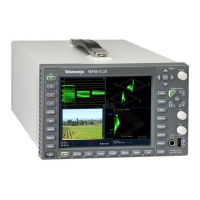Specifications
Table 5: Eye Pattern Display (cont.)
Characteristic Performance requirement Reference information
SD
Overlay Overlays all bits to form each eye opening.
Useful for observing peak jitter
10 Eye Displays eye relative to the parallel clock.
Useful for observing jitter correlated to w ord
clock
HD
Overlay Overlays all bits to form each eye opening.
Useful for observing peak jitter
Display Modes
20 Eye Displays eye relative to the parallel clock.
Useful for observing jitter correlated to w ord
clock
Vertical Scale Accuracy 800 mV ±5% w ith an 800 mV
p-p
input signal
Horizontal Scale A ccuracy Indicated t ime per division ±1%, fully digital
system
Rise Time
/ Fall Time,
Typical
Measurements only valid on a c lean signal.
Excess jitter, overshoot, or other aberrations
will reduce the accuracy. Limited by inherent
rise time of eye display
Eye Derived
Measurements
Amplitude,
Typical
± 10mV
Measurements only valid on a c lean signal.
Excess jitter, overshoot, or other aberrations
will reduce the accuracy. Limited by inherent
rise time of eye display
Equalized Eye Display
Shows eye from input after it has gone through
equalizer
Allows limited use of eye at long cable length.
Equalizer adds some jitter. Can bypass
equalizer at short cable lengths to overcome
this effect
Equalized Eye Amplitude, Typical 600 mv ±80mv
Amplitude of equalized eye is not related to
input amplitude. This waveform is from the
digital output of the equalizer. It is intentionally
displayed at a smaller s ize to reduce the
chance of i t being confused with the input eye
6 Waveform Monitors Specifications and Performance Verification

